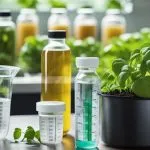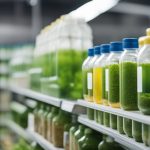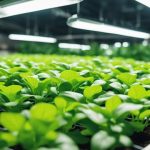Hydroponics is a method of growing plants without soil, using mineral nutrient solutions in a water solvent. This technique allows you to grow plants in environments where traditional agriculture might be impossible. By providing the essential nutrients directly to the plant’s roots, hydroponics can result in faster growth and higher yields. But what nutrients do I need for hydroponics? Understanding the specific ones your plants need is crucial for hydroponic success.

When setting up your hydroponic system, consider the nutrients as the building blocks of plant growth. Each nutrient plays a unique role; macronutrients like nitrogen, phosphorus, and potassium are the heavy lifters, supporting overall growth, root development, and flowering. In addition to these, plants need a series of micronutrients, including but not limited to, iron, manganese, and copper, which are critical even in small amounts. Managing these nutrients with precision ensures your hydroponic plants remain healthy and productive.
Understanding Hydroponics and Nutrient Basics
In hydroponics, your plants rely entirely on a nutrient solution for their growth and health, as they don’t have soil to obtain their needs from. This makes understanding water’s role and the essential nutrients in your hydroponic system crucial for your plants’ vitality.
The Role of Water in Hydroponics
Water is the lifeblood of any hydroponic garden. It acts as the carrier for the nutrient solution, delivering vital macronutrients and micronutrients to your plants’ roots. In a hydroponic system, the water quality and purity are paramount since contaminants can affect the nutrient balance and, consequently, plant health. Regularly check the water’s pH and electrical conductivity (EC) to ensure that the environment is optimal for nutrient uptake.
Essential Nutrients for Plant Health
Your plants need a precise balance of nutrients to thrive in a hydroponic system. These nutrients can be categorized into two groups:
- Macronutrients: These are required in larger quantities. They include:
- Nitrogen (N)
- Phosphorus (P)
- Potassium (K)
- Calcium (Ca)
- Magnesium (Mg)
- Sulfur (S)
- Micronutrients: Needed in smaller quantities but are still essential. They include:
- Iron (Fe)
- Boron (B)
- Chlorine (Cl)
- Manganese (Mn)
- Zinc (Zn)
- Copper (Cu)
- Molybdenum (Mo)
- Nickel (Ni)
Without soil, you’re responsible for providing these nutrients through a nutrient solution. The correct nutrient composition is crucial for different stages of growth, from leaf development to flowering.
For more information about the specific roles and indicators of adequate nutrient levels, referencing the GrowGeneration guide may be beneficial.
Macronutrients and Their Functions
Understanding the role of macronutrients is crucial for the development and health of your plants. Let’s break down these nutrients and their specific functions.
Primary Macronutrients: NPK
Nitrogen (N) is fundamental for leaf growth and is a key component of chlorophyll, which plants use for photosynthesis. It’s also essential in forming amino acids, the building blocks of proteins. For healthy foliage and overall growth, a balanced nitrogen level is vital.
Phosphorus (P) contributes to root development and is integral for flower and fruit formation. It also plays a part in energy transfer within the plant. If you want robust roots and bountiful blooms, phosphorus cannot be overlooked.
Potassium (K) regulates plant processes, including water uptake and photosynthesis. It also fortifies plant tissue, which can increase resistance to diseases. Potassium’s role is to ensure your plants are healthy and their metabolic functions are running smoothly.
It’s important to maintain the correct NPK ratio in your nutrient solution for optimal plant health.
Secondary Macronutrients
Calcium, magnesium, and sulfur are the secondary macronutrients necessary for plant growth but are required in smaller amounts compared to NPK.
Calcium (Ca) is a cornerstone in maintaining cell integrity and promoting proper cell division and growth.
Magnesium (Mg) is the central atom in chlorophyll, crucial for photosynthesis, and is involved in enzyme activation.
Sulfur (S) plays a significant role in producing proteins, vitamins, and enzymes.
These secondary nutrients must be present in your solution for your plants to thrive. Without them, you may encounter deficiencies that can significantly affect your plant’s health and yield.
Micronutrients: The Vital Additives
While macronutrients often get the spotlight in hydroponic gardening, it’s the micronutrients that play an essential but often understated role. These are the elements your plants require in smaller amounts, yet they’re absolutely critical for the well-being and optimal growth of your plants.
Common Hydroponic Micronutrients
Your hydroponic system relies on these key micronutrients to ensure plant health:
- Iron (Fe): Crucial for chlorophyll formation and function, it plays a significant role in photosynthesis and respiration.
- Manganese (Mn): Involved in enzyme activities, chlorophyll production, and mitigates the impact of high light intensity on the plants.
- Zinc (Zn): Essential for the synthesis of certain proteins and the promotion of growth hormones.
- Boron (B): Aids in cell wall formation and improves the overall movement of sugar and nutrients in plants.
- Copper (Cu): Integral for photosynthesis, as it acts as a catalyst in reducing molecular oxygen to water.
- Molybdenum (Mo): Necessary for nitrogen assimilation, as plants require it to convert nitrates into organic forms.
- Nickel (Ni): Although required in very small amounts, it’s vital for nitrogen metabolism.
The Importance of Trace Elements
You’ll find that trace elements, though needed in minuscule quantities, are essential nutrients for hydroponically grown plants:
- Chlorine (Cl): Even though it seems counterintuitive, in tiny amounts, chlorine is necessary for osmosis and ionic balance, which keeps plants turgid.
- Trace Elements Table
| Element | Function in Plants |
|---|---|
| Iron | Synthesis of chlorophyll |
| Manganese | Enzyme activity and chlorophyll production |
| Zinc | Protein synthesis and growth regulation |
| Boron | Structural and functional integrity of cellular walls |
| Copper | Essential in photosynthetic and respiratory electron transport chains |
| Molybdenum | Conversion of nitrates into amino acids |
| Nickel | Key in enzymes involved in nitrogen metabolism |
Ensuring a balanced supply of these trace elements is as vital as providing the right light and water conditions. Their absence or deficiency can lead to a spectrum of growth issues, so monitoring their levels will keep your plants thriving.
Related: Are you noticing the very tips of leaves turning yellow? Your plants may be experiencing nutrient burn. Find out what it is and how to fix it.
Preparation and Management of Hydroponic Nutrients
Properly preparing and managing hydroponic nutrients ensures your plants get the balanced feed they require for optimal growth. A well-crafted nutrient mix supports different growth stages and can help prevent nutrient deficiencies.
Mixing Your Own vs. Premade Solutions
Mixing Your Own: Crafting your own nutrient solution gives you the flexibility to tailor the mixture to your plants’ specific needs. When mixing nutrients from dry concentrates or liquids, you’ll need to carefully measure and blend the primary macronutrients—nitrogen (N), phosphorus (P), and potassium (K)—alongside essential micronutrients. Precision is key, as mistakes can lead to imbalances and potential harm to your plants.
- Start by adding micro-nutrients before macro-nutrients to prevent precipitation.
- Always mix nutrients thoroughly in water to ensure they’re fully dissolved.
Premade Nutrient Solution: For convenience, premade nutrient solutions are a straightforward alternative. These pre-balanced formulas are designed to take the guesswork out of the equation and are typically available as liquid concentrates.
- Choose a reputable brand to ensure quality and consistency.
- Follow the manufacturer’s instructions to dilute the concentrate correctly with water.
Related: Do hydroponic nutrients expire? Yes, they do. Find out for how long pre-mixed nutrients and nutrients mixed in water last in our comprehensive guide.
Adjusting Nutrient Solutions for Various Plant Stages
Different stages of plant growth require different nutrient formulations. During the vegetative stage, a higher nitrogen content is beneficial for leaf and stem development. As your plants transition to the flowering stage, they need more phosphorus and potassium to support blooms and fruit set.
- Monitor your plants for signs of nutrient deficiencies or excesses, adjusting your nutrient mix as needed.
- Regularly check the hydroponic pH of your nutrient-rich water solution to maintain a level suitable for nutrient uptake, usually between 5.5 and 6.5.
In both cases, whether using a homemade mix or a premade solution, the care taken in preparation and regular management of your hydroponic nutrients will greatly influence the health and yield of your garden.
Frequently Asked Questions
In the world of hydroponics, nutrients are your plants’ lifeline. Understanding what your plants need can greatly impact their growth and yield.






